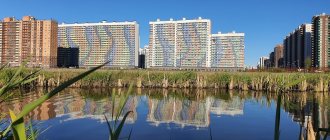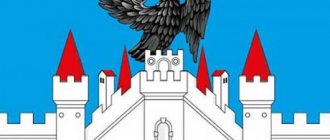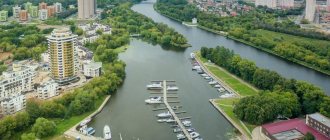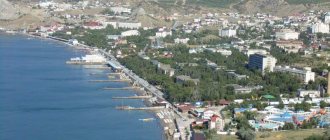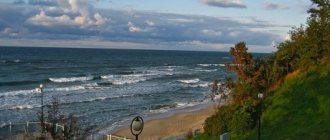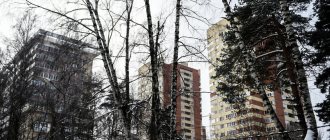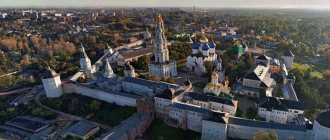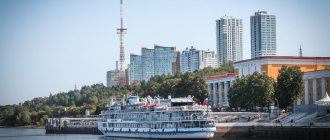| Flag of Dubna | Coat of arms of Dubna |
| A country | Russia |
| Subject of the federation | Moscow region |
| Urban district | Dubna |
| Population | ▲ 57,701 people (2010) |
| Confessional composition | Orthodox, Jews, Muslims. |
| Former names | Ivankovo |
| Based | 1956 |
| Coordinates | Coordinates: 56°45′00″ N. w. 37°09′00″ E. Longitude / 56.75°N w. 37.15° east d. (G) (O) (I) 56°45′00″ n. w. 37°09′00″ E. Longitude / 56.75°N w. 37.15° east d. (G) (O) (I) |
| Center height | 125 m |
| Vehicle code | 50, 90, 150, 190 |
| Agglomeration | 100,000[source not specified 219 days] |
| Official site | link |
| Square | 71.66 km² |
| City with | 1956 |
| Postcode | 141980 - Institutskaya Chast district, 141981 - Bolshaya Volga district, 141986 - Chernaya Rechka district, 141983 - Left Bank district |
| Mayor | Valery Eduardovich Prokh |
| OKATO code | 46 418 |
| Timezone | UTC+4 |
| Telephone code | +7 49621 |
| Ethnobury | Dubna residents, Dubna resident |
| Density | 986 people/km² |
| Internal division | Bolshaya Volga, Left Bank (30), Yurkino, Institutskaya part, Black River, Ratmino, Aleksandrovka |
| First mention | 1134 |
| National composition | Russians, Ukrainians, Jews, Tatars |
Dubna is a science city in the north of the Moscow region (125 km from Moscow, on the border with the Tver region), the largest center for research in the field of nuclear physics in Russia. Population - 70.7 thousand people (2010).
The city is located on the Volga River, bounded by the Dubna and Sestra rivers, the Moscow Canal and the Ivankovo Reservoir. Territory - 7166 hectares. The final point of the railway line from the station. Verbilki of the Savelovsky direction. On the territory of the city there is the Ivankovskaya hydroelectric power station, along the structures of which there is a road crossing connecting the city district “Left Bank” (the local name, “thirty”, comes from the name of the plant located on the territory of the left bank) with the right bank, on which the rest of the city is located. (“Big Volga”, “Black River” and “Institutional part”). In addition, the city includes the villages of Ratmino and Yurkino, as well as the village of Aleksandrovka.
Population
The total population of Dubna is 62,733 people as of January 1, 2010). About 30% of the working population of Dubna are employed in the field of science and scientific services, 12% of the population have academic degrees.
Dynamics of population changes
Population growth chart in Dubna (1959—2008)
Education and science
Coat of Arms (1976)
23 preschool institutions, 12 state and 3 non-state schools. Moscow Regional Industrial and Economic College, Moscow Regional Agrarian and Technological College, Center for Children and Youth Tourism and Excursions.
Universities:
- branch of the Moscow State University of Service (MGUS).
- representation of the International Academy of Assessment and Consulting (IAOC); (It does not work)
- branch of the Moscow State Institute of Radio Engineering, Electronics and Automation (Technical University);
- Research Institute of Nuclear Physics, Moscow State University;
- representative office of the University of the Russian Academy of Education (URAO);
- International University of Nature, Society and Human “Dubna”;
Live in Dubna: wait for the bridge across the Volga, listen to Vysotsky and be proud of physicists
The Moscow region science city of Dubna is proud that outstanding nuclear physicists worked here, Vladimir Vysotsky gave concerts at the local cultural center, and in the periodic table there is an element dedicated to the city - dubnium. Dubna stands on the Volga, here is the only river lighthouse in the Moscow region and the largest monument to Lenin in Russia. A native resident of the city, Anna, who is connected with Dubna by family history, spoke about where to look for the heart of the city and why Muscovites move to Dubna.
Living in Nekrasovsky: being half a summer resident and walking in a Gothic estate >>
From Moscow to Dubna
It was no coincidence that I ended up in Dubna; all my ancestors were from these places. My great-grandmother and her parents, grandparents were from villages on the outskirts of Dubna: Kriyanovo, Zakharkovo, Trinity, Skopinka, Strelka and others. The modern city has absorbed most of them.
A post shared by Dubna V Kadre (@dubna_v_kadre) on Apr 18, 2018 at 12:17pm PDT
The great-grandmother’s family had a large house in the village, which is located on the other bank of the Dubna River from Yurkino Street. On the eve of the Great Patriotic War, my great-grandmother entered the sapper school, and in 1941 she went to the front as a sapper. She went through the entire war and received the rank of colonel. For her military services, she received an apartment in Moscow, where her son was subsequently born - my grandfather, my mother and me. This is how our family’s Moscow page began.
A post shared by Dubna V Kadre (@dubna_v_kadre) on May 7, 2021 at 3:47am PDT
In the village we still had a 19th century house, where I spent the summer with my many relatives. My aunt had an apartment in Dubna itself, where I visited during the winter holidays. I grew up and studied in Moscow, and after college I firmly decided to move to my favorite city, because in Moscow I felt bad among the concrete and cars. I moved to Dubna and don’t regret it at all. This is my home and my family.
Live in Zaraysk: be proud of history and earn money from your hobby >>
Live in academicians' cottages
group “Dubna in the frame” on the social network “VKontakte”
To my great regret, the city is growing rapidly, and in a couple of decades there will be more than 100 thousand inhabitants. Many picturesque places are being built up with high-rise buildings. The “Big Volga” area has long been reminiscent of a residential area of Moscow.
I live in the most beautiful place in the city - in the institute part, in the old center with private Stalinist cottages. Locals call the institute part simply ICH. These “academics’ cottages” are the main feature of Dubna. Your acquaintance with the city will not take place if you have not admired these houses, built in the Stalinist Empire style in the 50-60s of the last century.
Previously, professors of the Joint Institute for Nuclear Research (JINR), who made a great contribution to the development of elementary particle physics, lived in such cottages. Streets in the old city center are named after these outstanding scientists - Flerov, Dzhelepov, Bogolyubov, Frank, Kurchatov and others.
A post shared by Dubna V Kadre (@dubna_v_kadre) on Apr 6, 2021 at 9:02am PDT
In the institute part of Dubna, you can see a memorial plaque literally at every step, so city guides recommend keeping Wikipedia at the ready. By the way, you will also remember part of the school physics curriculum while walking around the center of Dubna.
Several Stalinist cottages and the streets of ICh themselves became the heroes of the cult film of the 2000s “Brigada”. It was in such a cottage of academicians that violinist Olga Surikova, the beloved of the main character of “The Brigade,” lived. To show the audience what kind of intelligent environment the heroine came from, the director chose our places. And in the autumn forests of Dubna, various gang wars were often filmed.
Living in Nakhabino: leaving the house into the forest and being proud of the defense industry >>
Loving Vysotsky and riding a bicycle
© RIAMO, Tatyana Kezhaeva
Dubna is a city of monuments, only in the institute part there are a great many of them. For example, in the vicinity of the House of Scientists on Joliot Curie Street you can see an interesting sculptural composition - a meeting of two scientists Bruno Pontecorvo and Venedikt Dzhelepov. The physicists seem to be talking, and one of them is with a bicycle. Both scientists lived and worked in Dubna.
Pontecorvo was an Italian of Jewish descent. He is considered the founder of high-energy neutrino physics. He came to Dubna in 1950, when a secret hydraulic engineering laboratory was still functioning here. And, perhaps, it was Pontecorvo who introduced the fashion for bicycles in Dubna, because even now it is a very bicycle-friendly city.
Next to the Mir cultural center, also built in the 50s, there is a monument to the legendary Vladimir Vysotsky. Vladimir Semenovich loved Dubna, often came here to relax and gave several major concerts and even dedicated a song to nuclear physicists. The alley on which the monument stands is named after Vysotsky.
© RIAMO, Tatyana Kezhaeva
On Vysotsky Alley there are 20 mosaic panels by the French artist Nadia Leger with images of artists and politicians. There is an interesting story associated with these panels. They came to our city by accident and even without the knowledge of the author. Once upon a time, the artist donated her panels to the Soviet Union, but they lay in storage for a very long time. When the artist wanted to see where her works were located, Dubna “sheltered” the panel in her home so that there would be no embarrassment.
Live in Balashikha - walk in Gorenki and return from Moscow by taxi >>
Volga lighthouse and giant Lenin
A post shared by Dubna V Kadre (@dubna_v_kadre) on Apr 12, 2021 at 12:46am PDT
The Great Volga Lighthouse, which can be seen at the entrance to the city, can also be considered a monument. It is at this place that the Moscow Canal flows into the Ivankovskoye Reservoir - the so-called Moscow Sea. In 1933, an expensive Fresnel lens was ordered especially for the lighthouse. This is the only river lighthouse in the Moscow region. The lighthouse stands in a romantic place, on a narrow spit that separates the Moscow Canal and Lebyazhye Lake.
© RIAMO, Tatyana Kezhaeva
Well, how can we not say about the monument to V.I. Lenin - the second largest monument to the leader in the CIS. Its height including the pedestal is 37 meters. Stalin once stood opposite, but it was demolished during the Khrushchev era.
group “Dubna in the frame” on the social network “VKontakte”
The monument to Lenin stands on an artificial island between the dam of the Ivankovskaya hydroelectric station and the lock of the Moscow Canal. The monument was erected in 1937 to mark the opening of the Moscow-Volga canal.
Living in Lobnya - acting in films and counting planes overhead >>
The heart of the city and local ghosts
A post shared by Dubna V Kadre (@dubna_v_kadre) on May 26, 2021 at 10:29am PDT
Each city has its own historical symbol, its own business card. And if for Muscovites it is the Kremlin, for St. Petersburg residents it is the Peter and Paul Fortress, then for Dubna residents it is Ratmino.
I really love photography and maintain a blog “Dubna in the Frame” on Instagram and VKontakte. For me, as an amateur photographer, the most favorite and important place in the city is the Church of the Praise of the Blessed Virgin Mary in Ratmino. The temple is located in a picturesque place where the Dubna River flows into the Volga, on a small hill. It was built in 1827 by the Vyazemsky landowners, owners of the Dubna estate. It burned down in the 1980s; all that remained of the manor house was the wine cellar. According to local belief, the ancient Dubna ghosts live here.
A post shared by Dubna V Kadre (@dubna_v_kadre) on Jun 1, 2021 at 12:34pm PDT
The last owner of the estate and adjacent lands was Ivan Petrovich Lyubomilov, with whose personality the legend of ghosts is connected. He acquired the lands of Ratmino in 1917, and in the same year, after the October revolution, he lost them. His further fate is unknown for sure - maybe he went into exile, maybe he stayed and ended up in the cauldron of repression. There is also a version that he was brutally killed by revolutionaries right in the estate, and the corpse was buried nearby in a pit.
© RIAMO, Tatyana Kezhaeva
When an agricultural school was later located on the estate, rumors spread among its students that the ghost of the former owner was wandering through the overgrown alleys, rustling leaves, creaking the floorboards of the old manor house and scaring the guards and lingering teachers to death with his coughing.
Today, on the former territory of the estate, the Ratmino Rest House is located. They say that vacationers and tourists still hear shuffling, coughing, and whispering, especially at night near the ruins of the former landowner's house.
Live in Kashira: stay awake for days on the Oka River and watch the “silver clouds” >>
Moscow prices and a bad maternity hospital
Dubna is a modern and rapidly developing city. Our infrastructure is well developed - there are Auchan and Perekrestok stores, a cinema, the Mayak shopping center, an embankment with a city beach, and a park with children's entertainment. In general, everything that should be in a modern city. At the same time, food prices in Dubna are no lower than in Moscow. You can only save on the service, but not much.
As a mother of a small child, I would like to point out that we have a lot of playgrounds, but there are practically no ramps for strollers! In most shops and houses, strollers must be pushed up steps.
Medicine, especially the maternity hospital and the hospital, is a separate issue and the pain of the townspeople - it’s hard to find a worse maternity hospital than ours! If you look at the reviews on the Internet, almost all of them will be negative. My personal birth story in Dubna only confirms this fact. Therefore, everyone who can, goes to give birth in Moscow or Dmitrov. At the same time, there are undoubtedly good doctors in clinics. I would like to note with gratitude several doctors - Laura Leonov, psychiatrist Surovtsev, gynecologist Vishnevskaya.
Living in Kolomna means going to museums and not going to Moscow>>
Work as physicists and lyricists
A post shared by Dubna V Kadre (@dubna_v_kadre) on Jun 11, 2021 at 12:30pm PDT
The city is home to the legendary JINR, around which modern Dubna grew in the 50s. This is the face and pride of the city. JINR accounts for half of the discoveries in the field of nuclear physics in the former USSR.
As a sign of recognition of the Institute’s outstanding contribution to modern physics and chemistry, one can regard the decision to assign the name “dubnium” to the 105th element of the periodic table in accordance with the location of the Institute, and to the 114th element the name “flerovium” in honor of the co-founder of JINR and long-term head of the nuclear laboratory reactions of Academician Georgy Flerov, during his activity elements with numbers from 102 to 110 were synthesized.
Currently, Academician Yuri Tsolakovich Oganesyan works at JINR, after whom element number 118 is named.
The glory of the institute in our time, of course, is no longer the same as during the Union, but it continues to work. It would seem that JINR is the best place for physicists, come and work. However, now the salaries of ordinary employees are low, although the institute provides housing and mortgages to young families. My husband, for example, went to work as a programmer in the Dubna special economic zone (SEZ). Salaries there are considered good, although they do not compare with Moscow in the same area. I work as a teacher at a school. Of course, many people strive for a career in Moscow, but it is important for us to live here, in nature.
group “Dubna in the frame” on the social network “VKontakte”
In Dubna you can get a good education. There are at least two decent schools in the city - No. 9 in the Chernaya Rechka district and No. 1 in the Thirty-twenty district. The level of the remaining ten schools, in my opinion, leaves much to be desired. Dubna also has its own university - the International University of Nature, Society and Man "Dubna", which is considered relatively good. However, many of my students, having graduated from school here, went to study in Moscow and St. Petersburg.
On the left bank of the Volga there is the largest district of the city - the so-called Thirty, which got its name from aircraft factory No. 30, which operated before the war. Now this is the famous mechanical engineering design bureau "Raduga", specializing in the development and production of cruise missiles for various purposes. And this is another glorious page in the history of our city.
Living in Bronnitsy: waiting for Messi, playing football and being proud of your jewelry >>
Take a taxi and wait for the bridge
© RIAMO, Tatyana Kezhaeva
© RIAMO, Tatyana Kezhaeva
© RIAMO, Tatyana Kezhaeva
© RIAMO, Tatyana Kezhaeva
1 of 4
Dubna is a distant suburb of Moscow, approximately 120 kilometers from Moscow. You can get there in different ways - by train, by bus or by car. You can adapt to any schedule - the same buses run every 40 minutes, more often in the morning. The fastest way is by personal car - you can do it in 1.5 hours, if there are no traffic jams. An express train gets to the center of Moscow in exactly two hours; a regular train takes longer. A ticket to Moscow costs 250-320 rubles.
In Dubna itself there are two main bus routes, with both buses and minibuses. Unfortunately, they do not capture remote parts of the city, such as Yurkino Street, the River Club and Centaur residential complexes and the entire Podberezye microdistrict on Thirty. You have to get there by taxi. In my opinion, this is not a very well-thought-out system, since a lot of people live in these remote parts of the city. There are no schools or kindergartens in these areas.
The condition of the roads is generally good: repairs are carried out every year, but, again, except in remote areas. But outside the city the picture is completely different. The road Dubna – Kletino – Dok (Kimry) has received the status of the worst road in Russia, and you cannot drive on it.
Like the residents of the Crimean peninsula until recently, the residents of Dubna are waiting for the completion of the bridge. It will connect the two banks of the Volga. Work began in December 2021 and should be completed by the end of this year. The length of the bridge will be 485 meters, with two lanes in each direction. The new bridge will connect Bogolyubova Avenue and Vernova Street on the right bank of the Volga and the exit to the Raduga sports and recreation center in the Dubna SEZ area on the left bank and, of course, will significantly improve the transport situation in the city.
Live in Kotelniki: eat fresh salads from Belaya Dacha and ride the metro >>
Sport
Stele at the entrance to the city
There are five sports complexes and three swimming pools in Dubna.
The city has its own teams for:
- football - FC "Dubna".
- American football - “Vityazi”.
Sections and schools that have trained athletes at the level of Russian and world champions:
- Sambo school of Boris Pivovarov;
- water skiing school of the Nekhaevsky brothers;
- table tennis section at the JINR stadium;
- JINR Weightlifting Section.
In general, as of the beginning of 2009, there were sections and associations in more than 30 sports in the city.
Dubna
Old Russian Dubna
The first sites on the site of modern Dubna date back to the Mesolithic and Neolithic eras. Prince Yuri Dolgoruky is considered to be the founder of ancient Russian Dubna. Dubna was founded in the first half of the 12th century as a fortification on the border with the Novgorod lands. Based on the materials presented in archaeological research, it can be judged that the fortress and the settlement that arose around it played an important trade, military and administrative role. Residents of Dubna were engaged in fishing, trade and crafts. The historical predecessor of the modern city lasted no more than a hundred years. Old Russian Dubna was destroyed during civil strife at the beginning of the 13th century. The Tatar-Mongol invasions could also have contributed to the disappearance of the fortress and settlement.
Ratmino and Gorodishche
Old Russian Dubna was never restored. Over time, the village of Ratmino and the village of Gorodishche appeared in its place. In the 18th century, the Tatishchev family became the owner of these settlements. In 1815, the village and village became the property of Elizaveta Tatishcheva, the former great-granddaughter of V. N. Tatishchev, the great Russian historian. Elizabeth married Prince Sergei Vyazemsky. In the 1880s, the son of Sergei and Elizabeth sold the village to Professor P. Shubinsky. Then the land on which Ratmino and Gorodishche were located changed hands twice. Shortly before the revolutionary events, entrepreneur I.P. Lyubomilov became the owner of this land. The history of the modern city of Dubna is also connected with other settlements: the villages of Ivankovo, Podberezye, Yurkino, Aleksandrovka and Kozlaki. Residents of these settlements were engaged in traditional peasant crafts - shoemaking, fishing and arable farming.
First half of the twentieth century
The life of the inhabitants of the settlements changed significantly only in the 1930s. The changes were associated with the construction of the Ivankovskaya hydroelectric station and the Moscow Canal. Several villages in the vicinity of construction sites had to be relocated. Among these settlements was the village of Ivankovo. In the new location, the settlement began to be called Novo-Ivankovo. In 1937, the construction of the Volga hydraulic structures was completed. The working settlement of Bolshaya Volga appeared next to them. In parallel with the construction of the Moscow Canal, an aviation enterprise was being built on the left bank of the Volga. A settlement of aircraft manufacturers, called Ivankovo, appeared next to the enterprise.
At the end of 1941, the Nazis tried to get to the Ivankovo Reservoir dam. However, the attempt was unsuccessful. German troops were stopped twenty kilometers from the dam. The enemy's plans included crossing the reservoir on ice and then striking in the rear. Workers of the Ivankovo reservoir were able to raise the dam gates, despite the forty-degree frost. As a result, water was released. The ice on the reservoir could not withstand the water pressure and burst. Thus, the Nazis' plans were thwarted.
City of Dubna
On July 24, 1956, by decree of the Presidium of the Supreme Soviet of the RSFSR, the modern city of Dubna was formed. Part of the village of Ivankovo was included in the new city. But after 2 years this territory was returned to the village. They tried to annex the workers' village of Ivankovo to Dubna in 1958. However, in the same year, a new decision was made - to assign the status of a city to the workers' settlement.
Dubna began its development as an international scientific center. The young city developed around the Joint Institute for Nuclear Research (JINR), which was created in March 1956 by eleven countries. In March 1957, the synchrophasotron was launched at JINR, which until 1960 remained the most powerful particle accelerator on the planet. The synchrophasotron began to be considered one of the main symbols of the development of science in the Soviet Union.
Despite the fact that Ivankovo became an independent city, it continued to play an important role in the development of neighboring Dubna. In terms of population, Ivankovo surpassed its world-famous neighbor. In addition, electricity was produced in Ivankovo. The city ensured passenger and freight traffic along the Moscow Canal and supplied the capital with water. The production of aircraft and guided cruise missiles was established in Ivankovo. In 1960, the question of unifying the two cities was raised. The merger took place in December 1960. The new settlement was named Dubna.
Second half of the twentieth century
In the early 1960s, in accordance with the first master plan, the creation of a unified architectural and planning ensemble of the city in Dubna began. Implemented year after year, this plan was further developed in the master plan created in the mid-1980s.
The city received a new impetus for development in the late 60s, when the construction of an instrument building began in the oldest district of Dubna, “Big Volga”. The first products of this enterprise were produced in 1973. A few years later, the Federal State Unitary Enterprise “Research Institute “Atoll”” was located in the same area, where the development of control systems for water areas of the USSR began. The appearance of “Atoll” changed the appearance of the entire “Big Volga”: social and engineering infrastructure was developed, and construction of multi-storey buildings began.
In 1980, the Olympic Games were held in Moscow. In this regard, the Space Communications Center began operating in Dubna, thanks to which television programs were broadcast abroad. The center helped establish telephone government communications with France, the USA and the UK. In 1980, Dubna began to be considered a major international teleport. Most of the television stories first passed through this city, and only after that they were included in the news programs of Central Television.
In the mid-80s, Dubna managed to establish itself as the largest production and scientific center not only in the Moscow region, but throughout the country. The small city had a developed system of healthcare, education and cultural institutions. The population of Dubna received high incomes.
A crisis
The successful development of the city was stopped in the 90s by the notorious socio-economic crisis. In Dubna, problems arise that are typical for most populated areas of the country: production stoppage, rising unemployment, non-payment of wages. The city administration was forced to focus on preserving the intellectual potential of Dubna. It was necessary to preserve scientific research bases. Thus, the Technopolis Dubna program was created. As part of this program, state-owned enterprises were restructured.
Innovations have significantly accelerated the process of overcoming the economic crisis. Thanks to the active process of transferring state-owned enterprises to the base of small and medium-sized businesses, by the beginning of the 2000s, the city budget consisted of almost half of the income received from these enterprises. Social and engineering infrastructures were transferred to municipal ownership, which helped avoid their collapse. Previously, the infrastructure belonged to city-forming enterprises.
Science City
Thanks to the joint efforts of the city administration and many influential residents of the city, Dubna managed to overcome the deep economic crisis. The city not only did not cease to exist, it also continued its further development. In addition to the municipal authorities, the scientific and business elite of the city took an active part in taking measures to overcome the crisis. In just a few years, Dubna has transformed from a dying settlement into a dynamically developing municipality. The economic crisis contributed to the accumulation of new experience, which was then used to further move forward.
In the early 2000s, the city administration initiated the development of a new city development program. Dubna should become a science city. The status of a science city was assigned to the city by Decree of the President of the Russian Federation V.V. Putin in December 2001. At the same time, the Dubna development program was approved, which continues its successful implementation to this day. In 2006, the creation of a special economic zone of technology-innovation type began in Dubna.
Many prominent scientists took and continue to take part in the development of the science city. Among these people there are many prominent politicians and designers of the Russian Federation. The famous Soviet hydraulic engineer S. Ya. Zhuk, for example, supervised the design and subsequent construction of the Moscow Canal, originating in Dubna, as well as the construction of the Ivankovskaya hydroelectric station. Aircraft designer A. N. Tupolev decided to locate an aircraft plant in Ivankovo. The first designer of the plant was S.I. Chetverikov, who became the director of the enterprise during the war years. Chetverikov was one of the creators of Soviet seaplanes.
Modern Dubna
In 1996, a new tradition appeared in Dubna - maintaining a list of honorary citizens of the city. The list is updated almost every year. Also in 1996, a tradition appeared to celebrate City Day on July 24. In honor of the emergence of a new custom, the city authorities prepared a gift for the townspeople: a clock tower, called “Big Ben,” was built on Peace Square. However, the name did not have time to take root. Soon the tower was renamed the “Prokho-Danilovsky Monastery”. Giving gifts to Dubna on City Day is also a kind of tradition.
In 2000, the JINR Directorate raised the issue with the City Duma and City Hall about renaming part of Inzhenernaya Street. This part was supposed to turn into an independent Meshcheryakova Street. JINR managed to achieve its goal. Meshcheryakova Street appeared between the Dubna Hotel and the former hostel on Mira Street. In front of the JINR administrative building there was an unnamed square, which was also proposed to be named after Meshcheryakov. However, the authorities did not pay attention to this idea.
In the early 2000s, city authorities allocated considerable funds from the budget for the improvement of the city. The section of the road connecting the 2 parts of Bogolyubov Avenue was finally formed only in 2001. The new road connecting the Black River and the Bolshaya Volga was opened with a solemn procession, which was timed to coincide with the next anniversary of Dubna. The winding section of Bogolyubov Avenue is popularly called “Mother-in-Law’s Language.” Academician Baldin Street and Vysotsky Alley appeared in the city. Both the street and the alley already existed. They were simply given new names, thanks to which they seemed to have reappeared. Vysotsky Alley offers residents of Dubna and guests of the city a short journey back in time. Thanks to the entrepreneur Vyazemsky, not far from the Mir cultural center, a corner of the city of Dubna in the 1960s was recreated.
